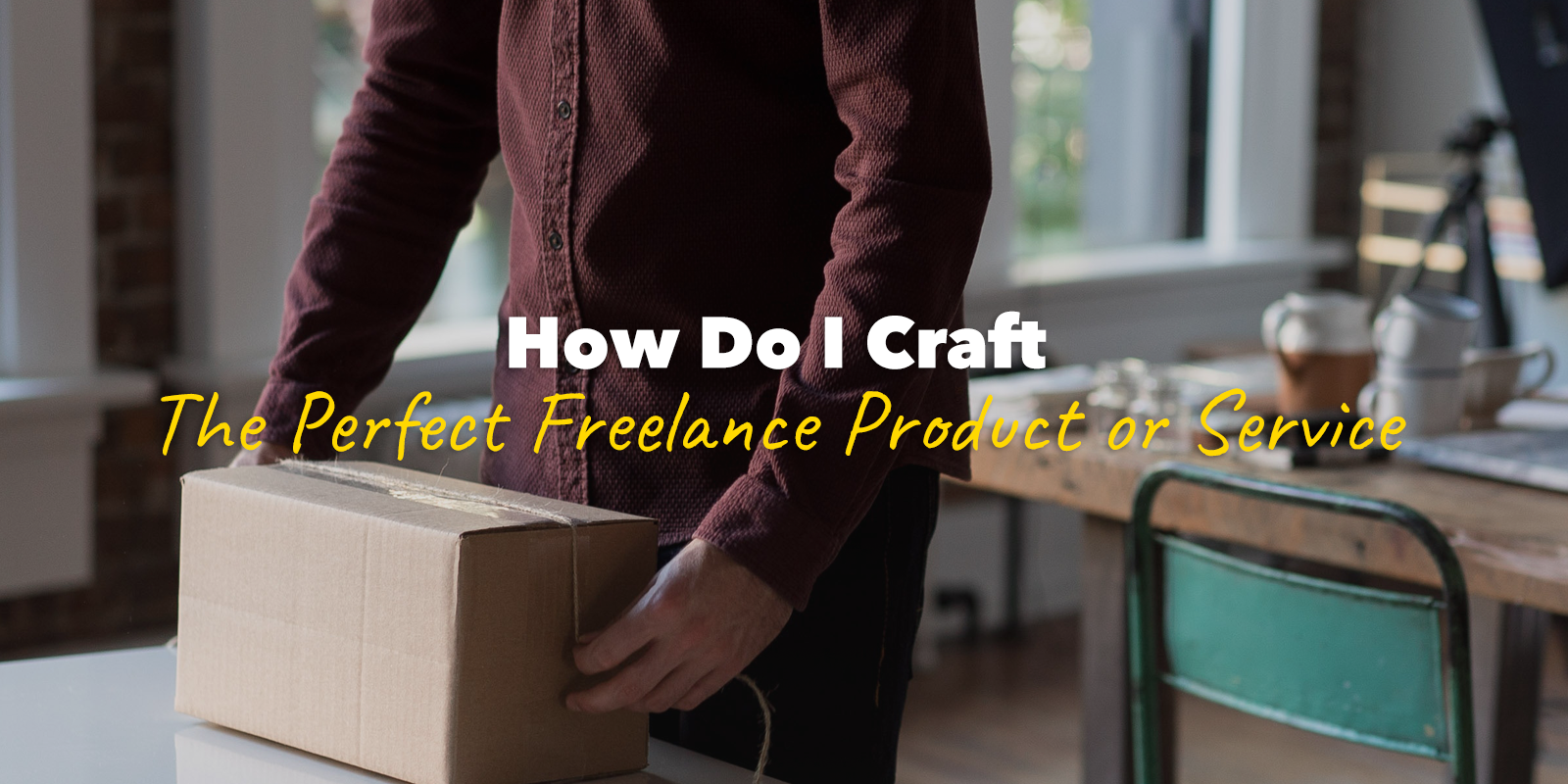If there were a formula for crafting the perfect freelance product or service, there would be only five essential ingredients.
- Find the place where you can have the deepest impact
- Unleash your best and remove the rest
- No pain, no gain
- Validate your idea
- Launch a Minimum Viable Product
When it comes to your client, there are only two positions that matter…
Where your client currently is (position #1)
And where they want to be (position #2)
The gap in between is a source of pain or frustration for your client. The job of your freelance product or service is to transition them from position #1 to position #2.
In simple terms, your product is the solution to your client’s problem.
Let’s dive into each essential ingredient, shall we?
Ingredient #1: Find the place where you can have the deepest impact
Let’s get this out of the way immediately…
If you’re helping everybody, you’re helping nobody.
To be a successful freelancer, with consistent, growing income, and your schedule being booked solid with new client work, there is no better way than to position yourself as the “go-to expert”.
You need to know who your freelance product or service will be for.
Here’s the thing, if you’re not serving a specific niche, and don’t have a target audience in mind, it’s next to impossible to be that go-to expert, because the general freelancing market is so overcrowded that there will be no way to stand out other than to compete on price.
And the winner of the price battle—contrary to most battles—is the one with the smallest price.
We’ve already determined in my recent 80/20 freelancing blog post:
- How you can workshop some ideas to land on the perfect niche
- Competing on price is unsustainable, and a terrible way to build a freelance business.
So, the narrower your target audience and more defined your niche, the deeper your potential impact. Therefore, your job is to find the place where you can have the deepest impact.
Where do you look for your target audience?
You don’t have to go far to find people you could help. Many of the people who could benefit from your offer are in your immediate connections. They are your family, friends, and in your professional network.
Family
This is a great place to start because you have seen first-hand their growing pains. Don’t feel bad about turning your family into your first clients. If they are purchasing similar products or services from someone else they are already someone’s client. This is a great opportunity to showcase you what you can do, and it may give you that much-needed boost when you’re just starting out.
Friends
Much like family, friends are those people who trust you, are easy to talk to, plus you already have an understanding of their lives, their businesses, their desires, their struggles — and if you don’t know these things, it’s pretty easy to find out over a few drinks, or dinner parties.
Professional Network
Your professional network has reach! Much further than you can reach by yourself. These are the people who have access to different business and can offer B2B connections. My biggest freelancing clients came from my colleagues referring me to their new boss. It literally pays to nurture relationships with your professional network. Remember businesses need products too!
Keep in mind, not everyone in your immediate circle will be a good fit for your product or service. In fact, most won’t be a good fit. You’ll need to narrow your selection to roughly match your ideal customer.
Ingredient #2: Unleash Your Best & Remove the Rest
You’re not good at everything.
And you shouldn’t try to be.
The most successful entrepreneurs in the world understand they are not good at everything, in fact, they’re often lousy at many things. So, what is it that makes them successful? There’s really no secret to it… They are world-class at one single thing. They unleash their best and remove the rest.
In simple terms, this means they build their products and services around their primary strengths, and either eliminate, automate or delegate the stuff they’re not so good at.
So, how can you apply this to your situation? You need to identify your strengths and weaknesses.
Your Primary Strengths (unleashing your best)
What makes you amazing?
(Don’t kid yourself, and don’t try to be humble, you are amazing.)
What is that thing that makes you different? What things are you truly great at? What do you love doing?
These questions may feel silly to you, but I promise you, the answer to these questions determine the foundation of your business, and whether or not you’ll have the stamina and passion to persist when things aren’t so easy. You wouldn’t pursue a goal you’re not excited about, would you?
Don’t think too hard. Just write them down. Set a timer for 3 minutes and don’t stop writing until the timer is done. Click this link to start a timer for 3 minutes, seriously.
I’ll be here when you’re done.
Now, try to categorize those strengths.
Are these strengths naturally inherited, or did you train to learn them?
Which of these are hard skills? And which are soft skills?
Why should you do this exercise?
If you’re serious about becoming a freelancer and building a product or service that matters to you, you need to figure these things out.
This outlines what you’re already good at right now. These are the strengths and skills you don’t have to wait to acquire. You already have something to work with and you can begin making progress on your product or service today!
Make sure your strengths are at the core of your product or service. Unleash your best!
Your Primary Weaknesses (removing the rest)
Now it’s time to face it and acknowledge our weaknesses. I’d argue that understanding your weaknesses is just as important as understanding your strengths.
You might already know your weaknesses, but if you need some help figuring them out, think about the following:
- What do you hate doing?
- What are you truly lousy at?
- What are some things you’re lousy at (but are still important)?
- What holds you back (emotionally, physically, spiritually)?
- What angers, saddens or depresses you?
- What are some undesirable personality traits?
Don’t think too hard. Just write. Do this for 3 minutes. Use this link to set a 3-minute timer.
Okay, now that you’ve identified your weaknesses, try to categorize them into one of the following:
Eliminate
These are the things that don’t serve you and deserve no part of your life or your business.
You must completely stop doing these things, remove them from your repertoire, rid yourself of them, and get them out of your life. If it’s a personality trait, a belief, a story you tell yourself, or something that makes you angry — what do you need to do to reduce or completely eliminate it from your life? If it’s something that constantly distracts you, and adds no value to your life — for example, social media, or reading the news — find a way to rid yourself of it. Is it an addiction? Acknowledge it, and get help to overcome it.
Automate
These are typically repetitive tasks that add value to your life or business but don’t need to be manually handled. You can use software to automate these things. Things like client on-boarding, answering common client questions, sending estimates & invoices, tracking finances, and logging vehicle mileage are just a few repetitive things we do as freelancers that can be completely automated with free or cheap software. Again, ensuring these tasks are handled is important and keep our business running, but they distract us and take time away from our flow, and as a result, our freelance businesses suffer.
Delegate
These are tasks and responsibilities that are fundamental to the success of our freelance businesses, but they need to be manually handled by a real human. For these things, you need to ask yourself — is this something I should be doing? Or should I have somebody else do them for me, so my time could be better spent elsewhere?
Things like managing projects, providing client support, accounting and taxes, handling legal matters, designing websites, back-end programming, and SEO are a handful of things that may be important to your freelance business, but should be delegated to somebody else, like a Virtual Assistant, Project Manager, Accountant, Lawyer, Graphic Designer, Developer, or Internet Marketer.
What do you do if one of the “weaknesses” on your list is something you actually want to be a strength?
Let’s say, for example, you want to craft a product or service around building custom WordPress websites. Perhaps you’re not that great at coding in PHP, but you know it’s important for building custom WordPress sites.
Simply perform an 80/20 analysis of PHP, and determine the essential parts of PHP you must focus on in order to get up and running as quickly as possible. You can gradually improve your skill level as you go, and hire help in the meantime, rather than waiting to be great at PHP before launching your product or service.
In conclusion, to build a freelance business and craft the perfect product or service, you’ll need to understand your weaknesses — and eliminate, automate or delegate them.
Ingredient #3: No Pain, No Gain!
Everyone has a problem they would like a solution to. Even better, many people would rather pay you to solve it for them rather than do it themselves. After all, that’s the reason we pay people to fix our car, hire a personal trainer, and order fast food instead of cooking.
You’ve discovered a niche, determined your strengths and weaknesses, now it’s time to understand the pain points of your target audience within your niche.
What do you think they struggle within their business? Is it a problem you, yourself, struggle with? Are you your target audience? This should be easy because you can build a solution that “scratches your own itch”, as Tim Ferriss likes to say.
Do some investigative work and read forums, comments on Facebook or LinkedIn groups, Reddit threads, and the comments section on popular blog posts within your niche.
Ask real people! Go to the places your target audience hangs out, whether online or in person.
One trick I like to use when I’m at my favorite local coffee shops is to ask the person serving me — often the owner or supervisor, since it’s a small business — “how is business this week?”
It’s a question they don’t often hear, and I’m usually surprised by the detail of their responses!
What are their pain points? How does it affect their lives and businesses?
Why have they not solved the problem themselves?
Are they currently paying for a product or service to solve this problem?
What is the optimal result they would like to see?
Collect as many responses as you can, and try to determine a pattern.
Based on your research, documenting your findings, and what people are telling you…
What can YOU do to solve that problem?
Ingredient #4: Validate Your Idea
Not long ago, large companies paid for focus groups in order to collect vital data and validate a business idea. The data they collected would help create some of the best products and services we use today!
The internet and social media have leveled the playing field for smaller companies and freelancers, like us, allowing the collection of data and product validation accessible to anyone.
Validation is vital to the success of your product or service. Validating your idea means you know, to some degree, that your product or service actually solves a problem and that your target audience is willing to pay for it.
So, how do you validate your freelance product or service?
Assuming you’ve determined your target audience and uncovered their primary pain points, here are just a few ideas to help you validate your idea:
Collect valuable feedback from your friends, family, social media, and ideally your target audience.
Ask important questions about your product or service, how they might use it, how well it solves the problem, and how valuable it is — among other questions.
The best way is to create an online survey to collect the data, my favourite tool for this right now is TypeForm — it’s free, easy to setup, and has a great user experience.
Gauge interest with a landing page
Use landing page software (free or otherwise) with details about your product or service, the problem it solves and an email signup form for people to learn more and be added to the interest list. This will help you gauge interest in your offer, and the emails you collect are your first list of leads!
Money talks
The best form of validation? Cold, hard cash (or an eTransfer or PayPal deposit).
If someone is willing to buy your product or service before it’s even launched, you know you’re on to something.
Before you launch, you may want to test and see how your target audience responds. Soft launches, or pre-launches, introduce your product or service to a restricted audience before you commit to a big launch.
A quick and easy way to soft launch is to put together a mockup, proposal or landing page with the details and a link to check out at a discounted “pre-order” price.
Answer these questions before you pull the trigger and soft-launch:
- Is the desired result of my product or service clear?
- Does my target audience understand what I’m offering and why it’s valuable?
- Is there a deadline for the target audience to see results?
- Can those results be measured?
- What needs to happen for this soft-launch to be considered a success
- and as a result, for my idea to be validated?
Ingredient #5: Launch a Minimum Viable Product
A minimum viable product (MVP) is a small product or service that meets the minimum requirements for solving your target audience’s problem.
It’s a strategy that many software startups use to launch their products in order to reduce the risk of wasting time, cost and effort to get it out in the world and start turning a profit.
As the MVP sells and is further validated, the company will re-invest profits and iteratively improve and grow the product.
You can use this exact same strategy as a freelancer with your own MVP.
Think of the biggest, best version of your product or service. Imagine that it runs like a machine, turns high profit, consistently adds new clients in the pipeline, with an effective marketing strategy that runs on auto-pilot.
Now imagine a tiny, little baby version of that product or service.
That’s where you are right now.
And that’s okay!
You don’t have to have to have the biggest, best product right now. Before you can get there, you need to start small with a simple, yet valuable solution that you know works. If your MVP is proven to be effective and valuable for your clients, just imagine how much better the full-featured version could be.
So, what is the simplest version of your freelance product or service you could offer?
Think of it this way…
You’ve got 48 hours to build and launch your product or service.
What does your product or service look like now that you don’t have time on your side? What does the absolute bare bones solution look like?
As your MVP turns a profit, and as you gain feedback and testimonials, you will organically improve your product or service and grow it into something much more significant and profitable.
Putting it all together
To review, in order to craft the perfect freelance product or service, you must:
- Find the place where you can have the deepest impact
- Unleash your best and remove the rest
- No pain, no gain
- Validate your idea
- Launch a Minimum Viable Product
This is the same formula used by multi 6, 7 and 8-figure enterprises. No matter your size, or your niche… If you follow this formula and put all of the ingredients together, you’ll have crafted the perfect freelance product or service that actually makes a difference.
Now, who’s hungry for success?
Need help crafting that perfect product or service? Download the workbook to help you put all of the pieces of the puzzle together.
You’ll also receive my free 7-day freelancing course, which has given more than 10,000 aspiring freelancers the roadmap for starting a successful freelance business.






